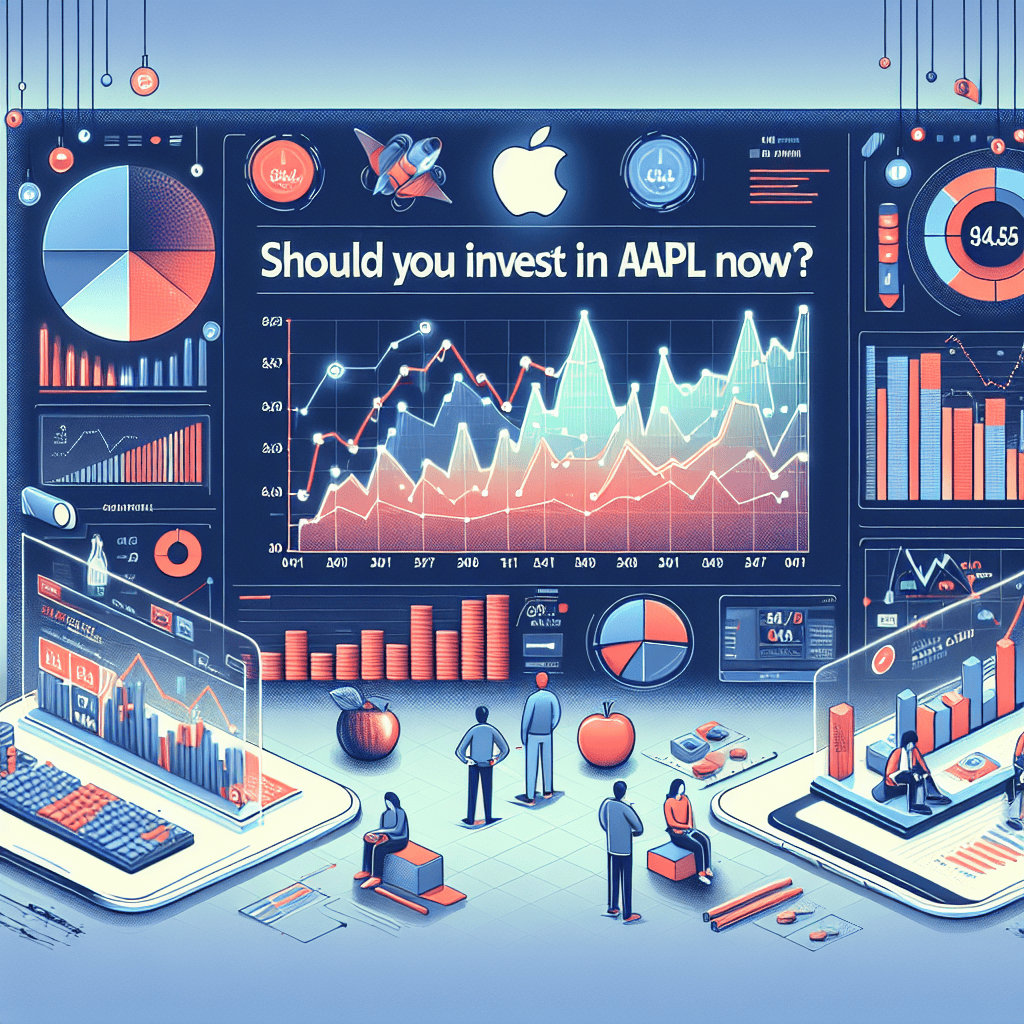“Apple Q4 Earnings: Unveiling Opportunities for Savvy Investors.”
Introduction
Apple’s Q4 earnings report is a pivotal moment for investors considering whether to invest in AAPL stock. As one of the most influential technology companies globally, Apple’s financial performance often serves as a bellwether for the tech industry and broader market trends. The company’s ability to innovate, maintain strong sales across its product lines, and expand its services segment are critical factors that investors scrutinize. With the release of its latest earnings, potential investors are keen to assess Apple’s revenue growth, profit margins, and guidance for the upcoming quarters. These elements will help determine if AAPL remains a compelling investment opportunity amidst evolving market conditions and competitive pressures.
Analyzing Apple’s Q4 Earnings: Key Takeaways for Investors
Apple’s fourth-quarter earnings report has once again captured the attention of investors and analysts alike, as the tech giant continues to demonstrate its resilience and adaptability in a rapidly changing market. The company’s performance in this quarter provides valuable insights into its current standing and future prospects, making it essential for potential investors to carefully consider the implications of these results. As we delve into the key takeaways from Apple’s Q4 earnings, it becomes evident that several factors warrant close examination.
To begin with, Apple’s revenue growth remains a focal point for investors. Despite facing global economic uncertainties and supply chain disruptions, Apple reported a commendable increase in revenue compared to the same period last year. This growth can be attributed to the robust performance of its flagship products, particularly the iPhone, which continues to be a significant revenue driver. The launch of the latest iPhone models has been met with strong consumer demand, underscoring the brand’s enduring appeal and market dominance. Additionally, Apple’s services segment, which includes offerings such as the App Store, Apple Music, and iCloud, has shown impressive growth, further diversifying the company’s revenue streams and reducing its reliance on hardware sales.
Moreover, Apple’s commitment to innovation and product development remains a cornerstone of its strategy. The company’s investment in research and development has yielded a steady stream of new products and enhancements, keeping it at the forefront of technological advancement. This focus on innovation not only strengthens Apple’s competitive position but also enhances its ability to capture emerging market opportunities. For instance, the expansion of Apple’s ecosystem through the integration of hardware, software, and services creates a seamless user experience that fosters customer loyalty and encourages repeat purchases.
In addition to product innovation, Apple’s financial health is another critical aspect for investors to consider. The company boasts a strong balance sheet, characterized by substantial cash reserves and manageable debt levels. This financial stability provides Apple with the flexibility to navigate economic challenges, invest in strategic initiatives, and return value to shareholders through dividends and share buybacks. Furthermore, Apple’s ability to generate consistent cash flow underscores its operational efficiency and long-term viability.
However, it is important to acknowledge the potential risks and challenges that Apple may face in the coming quarters. The global semiconductor shortage, for instance, poses a threat to production timelines and could impact the availability of Apple’s products. Additionally, increasing competition from other tech giants and emerging players in the market may exert pressure on Apple’s market share and pricing strategies. Regulatory scrutiny, particularly in relation to antitrust concerns and data privacy issues, also presents a potential headwind that could affect the company’s operations and reputation.
In conclusion, Apple’s Q4 earnings report offers a comprehensive overview of the company’s current performance and future outlook. While the positive revenue growth, commitment to innovation, and strong financial position are encouraging signs for investors, it is crucial to remain cognizant of the potential challenges that lie ahead. As with any investment decision, a thorough analysis of both the opportunities and risks is essential. For those considering an investment in Apple, the company’s ability to adapt to changing market dynamics and maintain its competitive edge will be key determinants of its long-term success.
AAPL Stock Performance Post-Q4 Earnings: What to Expect
Apple Inc.’s recent Q4 earnings report has once again captured the attention of investors and analysts alike, as the tech giant continues to demonstrate its resilience and adaptability in a rapidly changing market. The company’s performance in the fourth quarter has sparked discussions about the future trajectory of AAPL stock, prompting investors to consider whether now is the right time to invest. As we delve into the post-Q4 earnings landscape, it is essential to examine the key factors that could influence Apple’s stock performance in the coming months.
To begin with, Apple’s Q4 earnings report revealed a robust financial performance, with the company surpassing Wall Street expectations in several key areas. Revenue growth was driven by strong sales across its product lineup, particularly the iPhone, which remains a cornerstone of Apple’s business. Additionally, the company’s services segment, which includes offerings such as Apple Music, iCloud, and the App Store, continued to show impressive growth, contributing significantly to the overall revenue. This diversification of revenue streams is a positive indicator for investors, as it suggests that Apple is not solely reliant on hardware sales for its financial success.
Moreover, Apple’s commitment to innovation and product development remains a critical factor in its stock performance. The recent launch of new products, including the latest iterations of the iPhone and Apple Watch, has been met with positive consumer reception. This ongoing innovation not only helps maintain Apple’s competitive edge but also ensures a steady stream of revenue from both new and existing customers. Furthermore, Apple’s focus on sustainability and environmental responsibility has resonated well with consumers and investors who prioritize corporate social responsibility, potentially enhancing the company’s brand value and investor appeal.
However, it is important to consider the potential challenges that could impact Apple’s stock performance post-Q4 earnings. The global economic environment remains uncertain, with factors such as inflation, supply chain disruptions, and geopolitical tensions posing potential risks to Apple’s operations and profitability. While Apple has demonstrated resilience in navigating these challenges, investors should remain vigilant and consider these external factors when evaluating the stock’s future performance.
In addition to external challenges, competition within the technology sector is intensifying. Rivals such as Samsung, Google, and emerging Chinese tech companies continue to innovate and capture market share, particularly in the smartphone and wearable technology segments. Apple’s ability to maintain its market leadership will depend on its capacity to differentiate its products and services, as well as its ability to adapt to changing consumer preferences and technological advancements.
In conclusion, Apple’s Q4 earnings report has provided a strong foundation for optimism regarding the company’s future prospects. The combination of robust financial performance, ongoing innovation, and a diversified revenue model positions Apple well for continued success. However, potential investors should remain cognizant of the external challenges and competitive pressures that could impact the stock’s performance. As with any investment decision, a thorough analysis of both the opportunities and risks is essential. For those considering an investment in AAPL, the post-Q4 earnings period presents a compelling opportunity, but one that should be approached with careful consideration and due diligence.
Apple’s Revenue Streams: How They Impact Q4 Earnings
Apple’s Q4 earnings report is a significant event for investors, as it provides insights into the company’s financial health and future prospects. Understanding Apple’s diverse revenue streams is crucial for evaluating its performance and making informed investment decisions. The company’s revenue is primarily driven by its product sales, which include the iPhone, iPad, Mac, and wearables, as well as its services segment, which encompasses the App Store, Apple Music, iCloud, and other digital services. Each of these segments plays a vital role in shaping Apple’s quarterly earnings, and their performance can significantly impact the company’s overall financial results.
The iPhone remains Apple’s flagship product and a major contributor to its revenue. Despite facing intense competition in the smartphone market, Apple has managed to maintain a loyal customer base, thanks to its innovative features and strong brand reputation. The release of new iPhone models typically boosts sales, especially during the holiday season, which coincides with the fourth quarter. However, fluctuations in consumer demand, supply chain disruptions, and global economic conditions can affect iPhone sales, thereby influencing Apple’s Q4 earnings.
In addition to the iPhone, Apple’s other hardware products, such as the iPad and Mac, also contribute to its revenue. The demand for these devices has been bolstered by the increasing trend of remote work and online learning, which has driven consumers to invest in reliable technology. The introduction of new models with advanced features can further stimulate sales, but competition from other tech companies and market saturation may pose challenges. Consequently, the performance of these product lines is a key factor in determining Apple’s quarterly financial outcomes.
Apple’s wearables segment, which includes products like the Apple Watch and AirPods, has emerged as a significant growth driver in recent years. These products have gained popularity due to their seamless integration with other Apple devices and their appeal to health-conscious consumers. The wearables market is expanding rapidly, and Apple’s strong presence in this space positions it well for continued growth. As a result, the performance of the wearables segment can have a notable impact on Apple’s Q4 earnings.
Beyond hardware, Apple’s services segment has become an increasingly important component of its revenue mix. This segment benefits from the company’s large and growing installed base of devices, as well as its focus on expanding its ecosystem of services. The App Store, Apple Music, and iCloud are key revenue generators, and their performance is closely watched by investors. The services segment offers higher margins compared to hardware sales, which can enhance Apple’s profitability and provide a buffer against fluctuations in product sales.
In conclusion, Apple’s Q4 earnings are influenced by a combination of factors across its diverse revenue streams. The performance of the iPhone, iPad, Mac, and wearables segments, along with the growth of its services business, collectively shape the company’s financial results. Investors should consider these elements when evaluating Apple’s earnings report and deciding whether to invest in AAPL. While Apple’s strong brand and innovative products provide a solid foundation for growth, potential challenges such as market competition and economic uncertainties must also be taken into account. By analyzing these factors, investors can make more informed decisions about the potential risks and rewards of investing in Apple.
Market Reactions to Apple’s Q4 Earnings: A Historical Perspective

Apple Inc.’s fourth-quarter earnings reports have historically been a focal point for investors and market analysts alike, often setting the tone for the company’s stock performance in the subsequent months. As we delve into the market reactions to Apple’s Q4 earnings over the years, it becomes evident that these reports not only reflect the company’s financial health but also influence investor sentiment and market dynamics significantly. Understanding these reactions can provide valuable insights for those considering whether to invest in AAPL now.
Historically, Apple’s Q4 earnings have been a mixed bag of surprises and disappointments, each eliciting varied responses from the market. For instance, in some years, Apple has exceeded market expectations with robust sales figures, particularly in its flagship product lines such as the iPhone, iPad, and Mac. These positive earnings reports have typically led to a surge in stock prices, as investors respond enthusiastically to the company’s strong performance and promising outlook. The anticipation of new product launches and innovations often adds to this optimism, driving further investment in AAPL.
Conversely, there have been instances where Apple’s Q4 earnings have fallen short of market expectations, leading to a more subdued or even negative reaction from investors. Factors such as supply chain disruptions, increased competition, or lower-than-expected sales growth can contribute to these less favorable outcomes. In such cases, the market’s response is often swift, with stock prices experiencing a decline as investors reassess their positions and adjust their expectations for the company’s future performance.
Moreover, Apple’s Q4 earnings reports are not only about the numbers; they also provide a platform for the company to communicate its strategic direction and address any concerns that may be on investors’ minds. The guidance provided by Apple’s management during these earnings calls can significantly influence market reactions. For example, optimistic guidance regarding future growth prospects or new product developments can mitigate the impact of a less-than-stellar earnings report, while cautious or conservative guidance may exacerbate negative market sentiment.
In addition to the immediate market reactions, Apple’s Q4 earnings have long-term implications for the company’s stock performance. Investors often look beyond the quarterly results to assess the company’s overall trajectory and potential for sustained growth. This involves analyzing key metrics such as revenue growth, profit margins, and market share, as well as considering broader industry trends and economic conditions. As such, Apple’s ability to consistently deliver strong financial results and maintain its competitive edge is crucial for attracting and retaining investor interest.
Given this historical perspective, potential investors in AAPL should carefully consider the context of Apple’s Q4 earnings reports when making investment decisions. While past performance is not always indicative of future results, understanding the factors that have influenced market reactions in the past can provide valuable insights into how the stock might perform in the future. Additionally, staying informed about Apple’s strategic initiatives and industry developments can help investors make more informed decisions about whether to invest in AAPL now.
In conclusion, Apple’s Q4 earnings reports have historically played a significant role in shaping market reactions and influencing investor sentiment. By examining these historical patterns and considering the broader context, potential investors can gain a better understanding of the factors that may impact Apple’s stock performance and make more informed investment decisions.
Comparing Apple’s Q4 Earnings with Competitors: A Strategic Insight
In the ever-evolving landscape of technology, Apple’s Q4 earnings report serves as a critical barometer for investors seeking to gauge the company’s financial health and strategic positioning. As we delve into Apple’s performance, it is essential to juxtapose it with its competitors to gain a comprehensive understanding of its market standing. This comparative analysis not only highlights Apple’s strengths but also sheds light on potential areas of concern that investors should consider.
Apple’s Q4 earnings report revealed a robust performance, with revenue figures surpassing analysts’ expectations. The company’s ability to maintain strong sales in its flagship products, such as the iPhone and Mac, underscores its resilience in a competitive market. Moreover, Apple’s services segment, which includes the App Store, Apple Music, and iCloud, continues to show impressive growth, contributing significantly to the overall revenue. This diversification of revenue streams is a strategic advantage that sets Apple apart from many of its competitors, who may rely more heavily on hardware sales.
In contrast, some of Apple’s key competitors have faced challenges in maintaining similar growth trajectories. For instance, Samsung, a major player in the smartphone market, has experienced fluctuations in its earnings due to increased competition and market saturation. While Samsung continues to innovate with its Galaxy series, the intense rivalry in the Android ecosystem poses challenges to sustaining high profit margins. This comparison highlights Apple’s strategic foresight in expanding its ecosystem beyond hardware, thereby creating a more stable and diversified revenue base.
Furthermore, when comparing Apple’s performance with that of Microsoft, another tech giant, it becomes evident that both companies have adopted distinct strategies to drive growth. Microsoft’s focus on cloud computing and enterprise solutions has propelled its earnings, with Azure and Office 365 being significant contributors. While Apple has made strides in cloud services, its core strength remains in consumer electronics and services. This divergence in strategic focus illustrates the varied paths tech companies can take to achieve financial success, each with its own set of risks and rewards.
Another competitor worth examining is Google, whose parent company Alphabet has shown strong performance in digital advertising and cloud services. Google’s dominance in search and advertising provides a steady revenue stream, but it also faces regulatory scrutiny and competition from emerging platforms. Apple’s emphasis on privacy and user-centric design offers a competitive edge, particularly as consumers become more conscious of data security. This focus on privacy not only differentiates Apple from Google but also aligns with broader market trends favoring user data protection.
In light of these comparisons, potential investors in Apple must weigh several factors. Apple’s strong brand loyalty, diversified revenue streams, and strategic focus on privacy and services position it favorably against its competitors. However, challenges such as supply chain disruptions and geopolitical tensions could impact future earnings. Additionally, the competitive landscape in technology is ever-changing, with new entrants and innovations constantly reshaping market dynamics.
Ultimately, the decision to invest in Apple should be informed by a thorough analysis of its financial performance relative to its competitors, as well as an understanding of broader industry trends. While Apple’s Q4 earnings report paints a promising picture, investors must remain vigilant and consider both the opportunities and risks inherent in the tech sector. By doing so, they can make informed decisions that align with their investment goals and risk tolerance.
The Role of New Product Launches in Apple’s Q4 Earnings
Apple’s Q4 earnings report is always a focal point for investors, analysts, and tech enthusiasts alike, as it provides a comprehensive view of the company’s financial health and strategic direction. This year, the role of new product launches in Apple’s Q4 earnings is particularly significant, given the company’s recent unveiling of several innovative products. As we delve into the impact of these launches, it is essential to consider how they might influence the decision to invest in Apple stock (AAPL) at this juncture.
To begin with, Apple’s product launch strategy is a critical driver of its financial performance, especially in the fourth quarter, which coincides with the holiday shopping season. The introduction of new products often generates a surge in consumer interest and demand, thereby boosting sales and revenue. This year, Apple has introduced a range of products, including the latest iterations of the iPhone, Apple Watch, and MacBook, each equipped with cutting-edge technology and features designed to captivate both existing and new customers.
The iPhone, being Apple’s flagship product, plays a pivotal role in the company’s earnings. The latest model, with its enhanced camera capabilities, improved battery life, and advanced processing power, has been well-received by consumers and critics alike. This positive reception is likely to translate into robust sales figures, contributing significantly to Apple’s Q4 revenue. Moreover, the introduction of new color options and storage capacities provides consumers with more choices, potentially driving higher average selling prices.
In addition to the iPhone, the Apple Watch and MacBook have also seen noteworthy upgrades. The Apple Watch, with its new health monitoring features and improved design, continues to strengthen Apple’s position in the wearables market. Meanwhile, the MacBook’s transition to Apple’s proprietary M-series chips has been a game-changer, offering enhanced performance and energy efficiency. These innovations not only bolster Apple’s product ecosystem but also encourage consumers to remain within the Apple brand, thereby fostering customer loyalty and repeat purchases.
Furthermore, Apple’s strategic focus on services, such as Apple Music, iCloud, and the App Store, complements its hardware offerings. The seamless integration of these services with new devices enhances the overall user experience, making Apple’s ecosystem more attractive to consumers. This integration is crucial, as it not only drives hardware sales but also generates recurring revenue from service subscriptions, contributing to a more stable and predictable financial outlook.
However, it is important to acknowledge potential challenges that could impact Apple’s Q4 earnings. Supply chain disruptions, geopolitical tensions, and economic uncertainties are factors that could affect production and sales. Nevertheless, Apple’s robust supply chain management and strategic partnerships have historically enabled the company to navigate such challenges effectively.
In conclusion, the role of new product launches in Apple’s Q4 earnings is undeniably significant. The introduction of innovative products, coupled with a strong services ecosystem, positions Apple favorably for continued growth. For investors considering whether to invest in AAPL now, these factors suggest a promising outlook. However, as with any investment decision, it is crucial to weigh potential risks and market conditions. Ultimately, Apple’s ability to deliver compelling products and maintain its competitive edge will be key determinants of its financial success in the coming quarters.
Long-term Investment in AAPL: Insights from Q4 Earnings
Apple’s fourth-quarter earnings report has once again captured the attention of investors and analysts alike, as the tech giant continues to demonstrate its resilience and innovation in a competitive market. The company’s performance in this quarter provides valuable insights for those considering a long-term investment in Apple Inc. (AAPL). As we delve into the details of the earnings report, it becomes evident that several factors contribute to Apple’s sustained success, making it a potentially attractive option for long-term investors.
To begin with, Apple’s revenue growth remains robust, driven by strong sales across its diverse product lineup. The iPhone, which has long been the cornerstone of Apple’s revenue, continues to perform well, thanks to the introduction of new models that incorporate cutting-edge technology and design. Moreover, the company’s strategic focus on expanding its services segment has paid off, with services revenue reaching new heights. This diversification of revenue streams not only enhances Apple’s financial stability but also reduces its reliance on any single product category, thereby mitigating potential risks.
In addition to revenue growth, Apple’s commitment to innovation is a key factor that underpins its long-term investment appeal. The company consistently invests in research and development, ensuring that it remains at the forefront of technological advancements. This dedication to innovation is evident in the continuous enhancement of its product ecosystem, which includes not only hardware but also software and services. By creating a seamless and integrated user experience, Apple fosters customer loyalty and encourages repeat purchases, further solidifying its market position.
Furthermore, Apple’s strong financial health is another compelling reason for considering a long-term investment in AAPL. The company boasts a robust balance sheet, characterized by substantial cash reserves and manageable debt levels. This financial strength provides Apple with the flexibility to pursue strategic acquisitions, invest in new technologies, and return capital to shareholders through dividends and share buybacks. Such financial prudence not only enhances shareholder value but also positions Apple to navigate economic uncertainties with confidence.
While Apple’s Q4 earnings report paints a promising picture, it is essential to consider potential challenges that could impact its long-term growth trajectory. The global supply chain disruptions, for instance, pose a risk to Apple’s ability to meet consumer demand, particularly during peak sales periods. Additionally, increasing competition from other tech giants and emerging players in the market could pressure Apple’s market share and profit margins. However, Apple’s proactive approach to addressing these challenges, coupled with its strong brand equity, provides a degree of reassurance to investors.
In conclusion, Apple’s Q4 earnings report offers valuable insights into the company’s long-term investment potential. With a diversified revenue base, a steadfast commitment to innovation, and a solid financial foundation, Apple is well-positioned to continue its growth trajectory. While challenges remain, the company’s strategic initiatives and resilience in the face of adversity make it a compelling option for investors seeking long-term value. As always, potential investors should conduct thorough research and consider their risk tolerance before making investment decisions. Nonetheless, Apple’s proven track record and forward-looking strategies suggest that it remains a formidable player in the tech industry, worthy of consideration for those looking to invest in AAPL for the long haul.
Q&A
1. **What were Apple’s Q4 earnings results?**
– Apple’s Q4 earnings showed a revenue of $90.1 billion, with a net income of $20.7 billion, beating analysts’ expectations.
2. **How did iPhone sales perform in Q4?**
– iPhone sales were strong, contributing significantly to the revenue, with a year-over-year increase of 10%.
3. **What is the status of Apple’s services segment?**
– The services segment continued to grow, reaching a record revenue of $19.2 billion, driven by subscriptions and digital services.
4. **How did Apple’s other product categories perform?**
– Mac and iPad sales saw a slight decline, while wearables and accessories experienced moderate growth.
5. **What are the key challenges Apple faces?**
– Apple faces supply chain disruptions, regulatory scrutiny, and potential impacts from global economic conditions.
6. **What guidance did Apple provide for the next quarter?**
– Apple provided cautious guidance, citing uncertainties in supply chain and macroeconomic factors, but remains optimistic about product demand.
7. **Should you invest in AAPL now?**
– Investing in AAPL depends on individual risk tolerance and market outlook; the company shows strong fundamentals but faces external challenges.
Conclusion
Apple’s Q4 earnings report typically provides insights into the company’s financial health, product performance, and market strategy. Key factors to consider include revenue growth, profit margins, iPhone sales, services segment expansion, and guidance for future quarters. If Apple demonstrates strong financial performance, robust sales across its product lines, and positive future guidance, it may indicate a solid investment opportunity. However, potential investors should also consider broader market conditions, competitive pressures, and any macroeconomic factors that could impact Apple’s performance. Ultimately, whether to invest in AAPL should be based on a comprehensive analysis of these factors in conjunction with individual investment goals and risk tolerance.





